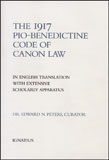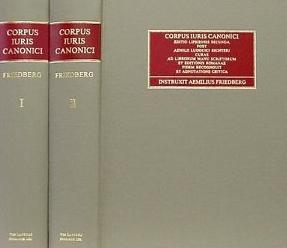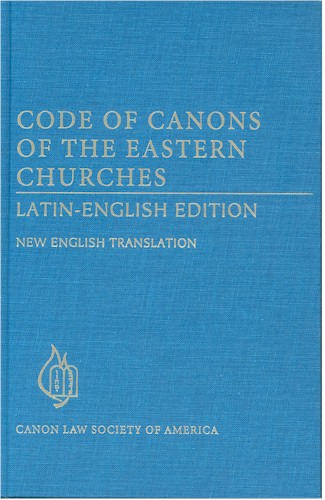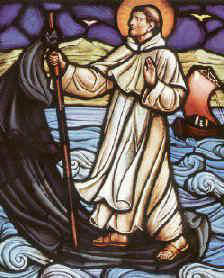|
Edward Peters, "Five
things every bishop needs to know about canon law", Catholic
Dossier (May-Jun 2001) 30-34. |
To make the claim that there are five
things every bishop needs to know about canon law suggests some possible assumptions that
should be considered prior to presenting the five points.
One assumption might be that bishops don’t already know the
five things I’ll recommend in this essay. But of course, making suggestions
does not imply that the recipient is unaware of the ideas. Given the Holy
See’s care in the selection of episcopal candidates, little in this essay will
come as a revelation to those men who have risen to the rank of diocesan bishop.
Instead, I hope that this formulation of certain suggestions might help bishops
to address canonical issues in a more fruitful way.
Others might suppose that, if bishops do not know and apply
the five things about canon law discussed herein, their ministries and dioceses
would be doomed to grave, perhaps irreversible, damage. To that let me observe
(none too originally) that if the Church were really at the mercy of any of the
various groups working within it (including canon lawyers), it would have
disappeared long ago. There is an element of that divine protection for the
Church as a whole that extends also to its legal system and its officers, a fact
which, provided it is not parlayed into an excuse for carelessness or abuse,
should be a consolation to us all.
Yet another assumption might grant that, while the aspects of
canon law presented here concern important matters in Church life, bishops ought
to be able to hand these matters over to knowledgeable and trustworthy
subordinates, freeing themselves to concentrate on more central ecclesial
issues. Canon law, after all, as John Paul II affirmed in his apostolic
constitution Sacrae disciplinae leges, “is not intended as a substitute
for faith, grace, charisms, and especially charity in the life of the Church (¶
16).”
Certainly it is true that in every governing structure, the
operations of its legal system eventually become the province of specialists,
and likewise that not every able leader in a society need be a legal scholar
thereof. In fact, for the Church’s first five centuries, no pope or bishop
could have told us clearly what canon law was. So much for its radical
necessity. But at the same time, no one denies that any leader, whether civil or
ecclesiastical, who has practical familiarity with the laws of that society,
will have an easier go of it. At a minimum, a firm grasp of the points outlined
below should aid bishops in recognizing canonical advisors worthy of their
confidence.
Having briefly addressed a few assumptions suggested by my
recommendations, I had planned to turn immediately to the specific points. But
almost the first thing I realized was that, had I been asked to write this essay
even five, but certainly ten, years ago, my first suggestion would have been
different from what it is today. The reasons behind this evolution are important
to consider.
Ten years ago, given ecclesiastical demographics, the typical
diocesan bishop in America would have been trained under the 1917 Code and,
although he might have had only a seminary sequence in canon law, nevertheless,
his canonical education would have highlighted the incredible length and breadth
of ecclesiastical issues treated by the Church’s legal system. Moreover, the
canonical concepts and categories he learned would have reflected those of St.
Pius X and Pietro Cardinal Gasparri. Of course, the Church and the world to
which it ministers underwent breath-taking changes in the decades following
1917, while codified canon law remained essentially unchanged until 1983. Thus,
to the bishop of ten years ago, my advice would have been something like:
“Please be conscious of the fact that the 1917 Code of Canon Law was
completely revised in 1983, and that consequently, many approaches to
ecclesiastical governance which were quite sound under the old code are
inadequate under the new.”
While I might have needed forgiveness for a certain temerity
then, the advice itself would have been basically sound. Paul VI had been
suggesting the same thing throughout the post-Conciliar canonical reform period.
The revised Code of Canon Law, he frequently observed, was going to require a
“novus habitus mentis” or a “new way of thinking,” in order to be
interpreted and applied correctly. John Paul II has made the same point
repeatedly throughout his lengthy pontificate.
Ten years ago, indeed, every practicing canonist had the
experience of advising bishops, (and not just bishops, of course, but they are
the focus of these remarks) who were clearly, however understandably, still
approaching issues treated under the 1983 Code with the assumptions and
techniques of the 1917 Code unduly in mind. Many times, to be sure, these were
minor matters which occasioned pleasant opportunities to explain some canonical
revisions; other times, though, the stakes were more serious, particularly when
bishops confronted problems requiring resort to sections of the law that had
undergone extensive revisions in the 1983 Code, major topics such as marriage
and annulments, the enhanced place of consultation and consent, substantive and
procedural rights of the faithful, and the implications of renewed
ecclesiastical subsidiarity.
It is Not as Hard as It Seems
Today, then, my suggestions must
take into consideration the fact that the number of diocesan bishops really
trained under the 1917 Code (as opposed to simply being ordained while it was
still technically operative) is small and dwindling. Moreover, canon law, and in
particular canon law training, suffered an inordinately long lame-duck period
due to the fact that the reform of the 1917 Code was announced in 1959, but was
not completed until 1983. The problem has, therefore, shifted from one wherein a
significant percentage of key ecclesiastical leaders received their formative
training under a legal system that had been abrogated, to one wherein many of
today’s ecclesiastical leaders received essentially no legal training
whatsoever.
Canon law was not exactly a popular academic major among
priests and seminarians, let alone laity, from the early 1960s to the 1980s.
Those relatively few who took anything more than, say, an overview course on
marriage law, generally had to study canon law from blurry photocopies of
various revision schemata constantly prefaced by comments like: "The most
recent proposal says . . ." or "One draft under consideration holds . .
." Against, then, the already aggravating backdrop of a pervasive post-Conciliar
antinomianism, young clerics saw that the days of the 1917 Code (in their minds,
a thick document indistinguishable from canon law in general) were clearly
numbered, while the absence of canon law textbooks in the classroom further
reinforced the perception that canon law was a discipline without clear
parameters. Canonistics, which till then had been a science shared by academe
and chanceries, became the nearly exclusive province of professors over
practitioners. Thus it happened that many men now ordained to the episcopacy
were first exposed to canon law during highly unsettled times, and they learned
to defer unnecessarily to canonical experts instead of attempting their own
informed reading of the text.
And so today, my first piece of advice to bishops concerning
canon law is simply this: Know that a venerable and complete legal system,
touching more or less directly every important aspect of Church life, exists in
one, comprehensive volume, and that regardless of your academic formation in
canon law, you can make effective use of this law in your ministry, perhaps in
ways you have never imagined before. I have worked with bishops who, while not
trained as canonists, nevertheless had read Church law carefully, so I know they
were in a much better position than were others to understand and make wise
selections from among the legitimate options their canonical advisors could
later set before them.
The second thing that every bishop needs to know about canon
law flows from the first and offers reinforcement of it. It too requires some
prefacing remarks.
The Catholic Church’s attitude toward canon law rests on
fundamentally very different foundations than does, say, the Anglo-American
attitude toward civil law. Grounding the American attitude toward law is the
idea that law is meant, in large part, to restrict the degree of authority
government has over our lives and that its legitimacy flows from the consent of
the people being governed. All of this is good healthy Lockean and Jeffersonian
democracy.
But contrast this with the Catholic Church’s attitude
toward its law. The authority of popes and bishops does not depend in any sense
on the consent of the subjects they govern. Church history shows us, in fact,
that the rise of canon law in the Church was not occasioned by the needs of the
faithful to mark out liberties in the face of a power-grabbing hierarchy, but
rather was spawned by the needs of shepherds in Christ to facilitate the
exercise of their pastoral jurisdiction and, over time, to bring consciously to
bear the virtues of justice and equitable treatment upon those blessed enough to
be called children of God. From its most ancient roots, then, canon law has been
a plow in the hands of the hierarchy, not a sword in the hands of the faithful.
The Law Favors Bishops
Thus, when the Legislator set his
signature to the 1983 Code, his primary goal was to ensure that the institution
founded by Christ to lead men to God, and the popes and bishops who rule over
that Church, would have the administrative wherewithal to accomplish their task
in an upright way. From this flows my second suggestion: Bishops need to be
conscious of the fact that the Code of Canon Law, for very sound theological and
administrative reasons, was written in their favor, and that therefore, provided
they follow its sometimes tedious requirements, they will be upheld in virtually
any dispute occasioned by their decisions and actions.
Let’s consider briefly two concrete problems most bishops
have to face sooner or later: the removal of an unworthy pastor before the
expiration of his term, and the closing of an all-but-abandoned parish. Now, no
bishop walks into his office and says, “Gee, I feel like having some fun
today. I think I’ll get rid of crazy Fr. Bob and then, I dunno, maybe I’ll
close a couple parishes.” To the contrary, both tasks are approached with a
heavy heart. Either scenario can provoke fierce opposition from clergy and
faithful alike. Both offer numerous opportunities for the disregard of rights,
the abdication of duties, and general discord among the People of God. But both
are problems long faced by Church leaders and both are capable of being justly
addressed in accord with canon law.
In the case of the removal of an unworthy pastor, for
example, a sequence of 12 canons (cc. 1740-1752) guides bishops and pastors
alike in reaching an informed decision about the priest’s continuance in
ministry, but at every stage, the 1983 Code clearly reinforces the ultimate
authority of the bishop over the situation. Similarly, though admittedly without
the neat sequence of steps laid down for pastor removal cases, bishops and
faithful confronted with the possibility of closing a parish must have resort to
the canons on juridic personality (cc. 113-123), ecclesiastical property (cc.
1254-1310), and delivery of pastoral services (cc. 515-552) to understand how in
fairness a bishop may proceed in order to arrange parishes as he ultimately
deems necessary. While the results in either case might not be to everyone’s
liking, the very appearance of having acted in accord with law and justice can
help sow the seeds of rehabilitation in the case of a priest removed from
ministry, or of reconciliation among new parishioners in the case of faithful
who have lost their former parish. I shall return to the importance of bishops
being seen as trying to do justice in my final suggestion.
What Goes on in the Tribunal
At this point, let me shift the focus away from internal matters that are of
interest primarily to Catholics, and look directly at an area in which many
non-Catholics, and sometimes secular society itself, maintain an ongoing
interest. I speak of marriage and annulments. To my third suggestion simply: Every diocesan bishop needs to understand the canons, both
substantive and procedural, under which his tribunal operates.
Tribunal work is an area in which non-canonist bishops seem
especially reluctant to enter. That’s understandable. Marriage canon law is
ancient and complex. It has spawned more canonical literature than all other
topics in canon law combined, making it a daunting field for non-degreed
persons. Diocesan tribunals operate under serious time and resource restraints,
and are often subject to extensive public criticism from the faithful, the
secular media, and other agencies in the Church, even though tribunals, due to
privacy constraints, can rarely reply with the kind of detail needed to address
such concerns. And, as if all those factors discouraging direct episcopal
involvement in tribunals were not enough, the basic facts on which most actual
annulment petitions turn are frequently depressing, tedious, saddening, and even
nauseating. I have offered the analogy of tribunals serving as crash
investigators, picking through the debris of wrecked marriages trying to figure
out what went wrong. There is nothing attractive about it, however important it
might be.
Despite these obstacles, canon law recognizes the diocesan
bishop as the chief judge in his diocese (c. 1419). It is difficult to see how
bishops can give effective leadership to their tribunals, at a time when they
might need it most, if they do not have an actual working knowledge of the
substantive canons on marriage and the procedural canons under which annulment
cases are heard. But even beyond that reason for deeper episcopal involvement,
tribunals are repositories of immense information on trends in marriage, or at
least trends in failed marriages. Any effort to communicate the insights of
tribunal personnel to those responsible for helping the bishop to develop
effective diocesan marriage preparation programs (and such coordinated efforts
are too few) would be greatly enhanced if the bishop himself thoroughly
understood what the tribunals are actually seeing and doing.
Advice or Consent
For my
fourth suggestion, I consider an
issue bishops face nearly every day and suggest that: Bishops need to understand
the greatly enhanced strengths, and the inescapable limitations, of the new
canonical requirements of consultation and consent as part of their regular
decision-making process. In a host of ways too numerous to list here, the 1983
Code, in contrast to the 1917 Code, requires bishops to seek advice sincerely
about, and at times to obtain consent to, many of their proposed actions.
This major change in approach comes as part of the general
tendency of the 1983 Code to grant local bishops much more decision-making
authority than was common under the former law. The new canons on consultation
and consent concretize the opportunity to make legitimate use of a wide range of
talents and expertise among the people of God in the local Church. But while
there is greater local autonomy for pastoral policies, there is also a greater
requirement to make sure such policies reflect local needs as opposed to
institutional preferences. Indeed, the scope of issues potentially involving
consultation or consent requirements is vast: ordination and continued ministry
of priests, most diocesan budget and finance issues, diocesan pastoral councils
and synods, distribution of parishes and numerous clergy matters, renovation of
churches, enactment of disciplinary norms, supervision of schools and, well, the
list just goes on and on.
But, to consider only the most basic distinction here,
consultation does not mean consent (c. 127) and bishops need to know in advance
which they are seeking, if only to explain to those with whom they are
conferring the differing expectations attached to their discussions.
Particularly in America, we are inclined to see committees and councils as
policy-making bodies, which under canon law they rarely are. At many times in
the past, such groups have had to be reigned in, a difficult task obviously, and
one that might not have been necessary if all those involved, including the
bishop, had been better able to articulate the theology and practical aspects of
the 1983 Code’s greatly enlarged emphasis on consultation and consent in
Church life.
An Aid to ‘Enforcement’
My fifth suggestion, like those above,
will not be news to bishops, but rather, affords them an opportunity to consider
how canon law is an important part of the Church’s overall structure and
contributor to its mission, and how their duties to enforce ecclesiastical
discipline (cc. 391-392) both depend on and contribute to their leadership in
other areas.
Canon law’s enforcement mechanisms differ profoundly from
that of any other major legal system. There are no canonical police, no
canonical jails. The direct financial power of the Church over its members is
limited to a tiny percentage of its population. Moreover, contrary to popular
perception, canon law cannot threaten recalcitrants with dire consequences in
the next life. (Well, not directly anyway.)
In a legal system, therefore, wherein physical, financial, or
eschatological coercion is all but non-existent, how do bishops enforce the law?
They do so most effectively by their own personal example of adhering to law. In
other words: Bishops must come to know and accept the operations of canon law in
their lives and ministries, in order to call, most convincingly, their subjects
to lives and works in accord with the ecclesiastical discipline by which all are
bound. A bishop who, notwithstanding only a cursory exposure to canon law many
decades before, really commits to knowing the canons affecting in his actions,
has the credibility to extend that requirement, adapted to their conditions, to
his priests, diocesan staff, parish workers, and faithful at large. A bishop who
accepts the limitations that canon law places on his own plans or preferences,
has the credibility to expect others to temper their desires in accord with that
same law. In brief, a bishop who lives with law can lead with law.
The final canon of the 1983 Code, treating dryly of some
procedural requirements to be honored in pastor transfer cases, concludes with a
remarkable crescendo, reminding bishops that “the salvation of souls, which
must always be the supreme law on the Church, is to be kept before one’s
eyes.” May the suggestions in this essay help our bishops to apply canon law
in ways ever more conducive to the good of the Church and the welfare of souls.
+++
|




